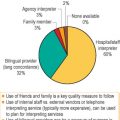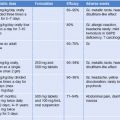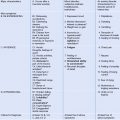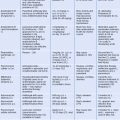CHAPTER 11 US Medical Screening for Immigrants and Refugees
Public Health Issues
The Health Needs of Refugees Justify Prompt Health Screening in the United States
The health needs of refugees resettled in the United States have been well documented. Although this is particularly so for refugees from Southeast Asia and the former Soviet Union, more recent reviews have incorporated findings from African refugee populations.1–8 These studies highlight the increased health morbidity of refugees, both adults and children. Refugees of many backgrounds now enter the country with a wide array of unmet health needs, including nutritional deficiencies, anemia, hepatitis B infection, tuberculosis infection, parasitosis, and other acute and chronic physical illnesses. While war and civil unrest have worsened the already poor health status of developing nations that are the sources of many refugees, developed countries such as those of the former Soviet Union and Yugoslavia have seen marked deterioration in national health status attributable to the turmoil in those regions.9,10
In addition to these physical health concerns is the vast burden of potentially long-term mental illness and emotional distress.11–13 Mental health concerns (including alcohol and drug abuse14) increasingly are garnering greater attention among the refugee resettlement and health communities. This is due both to the recognition of the violence directed at civilian populations in recent civil conflicts such as those of Bosnia, Rwanda, Somalia, and Sudan and an understanding of the impact of such violence on human beings.15–17 Alternatively, economic deterioration in the formerly socialist countries of Eastern Europe (such as the USSR) is believed to have contributed greatly to the declining quality of life and concurrent rise in alcohol and drug abuse there.10 Lastly, increased use of government-sponsored torture and child soldiers has exacerbated mental health issues for adults and children. Amnesty International has estimated that over 150 countries around the world practice government-sponsored torture against their citizens.18 Refugee populations have historically included high proportions of survivors of torture who have serious physical and mental health concerns related to their torture experiences.19
The Legal and Regulatory Basis of Refugee Resettlement and Health Screening
The Refugee Act of 198020 amended the Immigration and Nationality Act to establish a domestic refugee resettlement program. This legislation marked the inauguration of the modern resettlement era as it currently exists. The Refugee Act delineated the philosophical approach and the role of government in facilitating refugee resettlement, stating the objectives ‘to provide a permanent and systematic procedure for the admission to this country of refugees of special humanitarian concern to the United States, and provide comprehensive and uniform provisions for the effective resettlement and absorption of those refugees who are admitted.’21 The Act defined the term refugee, outlined the process for the annual admission of refugees, and established the Office of Refugee Resettlement (ORR) in the Department of Health and Human Services, through which resources for domestic resettlement would be made available.
In accordance with the Refugee Act, and as part of a consultative process on refugee admissions, the President annually provides Congress with information on refugee admissions priorities.22 Proposed admission numbers are ceilings and not goals. In addition to refugees from overseas, other individuals are eligible for refugee benefits and services, including the domestic health assessment. Recipients of political asylum must meet the same ‘well-founded fear of persecution’ test as a refugee, but they make their claims from within the US rather than another country. Asylees may then petition for visas for family members who arrive from overseas and are also eligible. Cuban and Haitian entrants have special immigration statuses that confer eligibility for refugee program participation. Finally, the Trafficking Victims Protection Act of 2001 granted certified victims of a severe form of trafficking eligibility for refugee benefits and services.
Public health activities delineated in the Refugee Act include notification to state or local health officials of each refugee’s arrival and monitoring of refugees to insure that they receive appropriate and timely treatment for health conditions of public health significance that are identified overseas.23 Furthermore, the ‘Director [of the Office of Refugee Resettlement] is authorized to make grants to, and enter into contracts with, State and local health agencies for payments to meet their costs of providing medical screening and initial medical treatment to refugees.’24
The implementing regulations of the Refugee Act further delineate the opportunity for states to provide domestic health assessment services with federal refugee funding support.25 To qualify, state health assessments need to be in accordance with ORR requirements, be approved in writing by the ORR director, and, if done within the first 90 days after a refugee’s entry into the US, can be provided to all individuals eligible for the federal refugee program.
Historical Perspective of the Health Screening of Refugees and Immigrants
The International Organization of Migration (IOM) conducts overseas screening of most refugee migrants to the US. IOM is an intergovernmental agency based in Switzerland that manages refugee movements for third-country resettlement. While destination countries such as the US, Canada, and Australia have different medical examination requirements and exclusionary criteria, IOM officials state the overarching goals of medical screening of migrants in four points: (1) to identify individuals with communicable diseases and thus to protect the public health in the receiving nation; (2) to prevent entry of individuals with health problems because they may constitute a financial burden or impose excessive demand on public health and medical services; (3) to ensure that as future residents the migrants will be healthy and productive (fit to work); and (4) to identify individuals in need of medical care in order to prepare the host country’s healthcare system to meet their needs.26,27
Countries such as the US that receive large numbers of immigrants and refugees have seen dramatic declines over time in domestic rates of some infectious diseases such as tuberculosis28 and vaccine-preventable diseases such as measles.29 In the face of an increasingly mobile global population, some infectious diseases such as these in the US are becoming concentrated among recently migrated immigrant populations.22,23 Consequently, US and IOM public health officials have recognized the need to rethink strategies for the overseas screening of immigrants and refugees.
Recent Trends in Overseas Screening and Implications for Refugee Health Programs in the US
After a refugee’s application for US resettlement has been approved by US immigration authorities, refugees undergo a health screening that is overseen by the CDC and implemented by the Migration Health Services of the IOM or local panel physicians under contract with US consular staff. The overseas screening is intended to identify conditions that will exclude the refugee from entering the US (‘class A conditions’) or warrant follow-up in the US (‘class B conditions’). The screening is limited in its scope and focused mainly on detection of infectious disease of public health significance (tuberculosis, HIV, and syphilis) and mental health or other problems that may result in harmful behavior towards himself/herself or others. The content is fully described in the Technical Instructions for Medical Examination of Aliens (Atlanta, GA: Centers for Disease Control and Prevention; June 1991: http://www.cdc.gov/ncidod/dq/technica.htm) and summarized in the preceding chapter.
Following the historic infection control tradition of refugee health assessment, class A conditions are generally infectious diseases. Other class A conditions include mental illness that is associated with violent or harmful behavior and substance abuse. While class A conditions are grounds for exclusion from the US, refugees may complete treatment to render the condition noninfectious or apply for a waiver to permit entry. The most notable of class A conditions are active infectious tuberculosis and HIV infection. Because of the humanitarian nature of their resettlement, unlike other immigrants, refugees with HIV infection may use a simplified waiver process to enter the US that releases them from the requirement of not being a public charge risk. Class B conditions are physical defects, diseases, or disabilities significant enough to cause functional impairment or require follow-up.
In the past decade, overseas screening of refugees has been the focus of applying modern epidemiologic and screening techniques.20 Recent attention has been placed on identifying health needs of specific refugee populations that are to resettle in third countries such as the US in order to improve health among that community and reduce transmission of disease among the future resettlement community.20,30,31 Thus, interest in the control and prevention of certain diseases among refugees has been rejuvenated by efforts to control infectious diseases at different levels: the whole population through mass empiric treatment and the individual migrant through targeted screening for and treatment of specific conditions.20,22
Once in the US, the question of how to address the health needs of refugees broadens beyond infectious disease screening. Domestic refugee health programs must consider the impact of changing overseas screening and empiric treatment on their clinical protocols and health needs of refugees while seeing them for screening. Similarly, as more empiric treatment is implemented overseas, chronic disease and mental health become more prominent as public health issues in the US at the state and local level. As such, one refugee health assessment program has implemented an innovative mental health screening program.32 Providing access to mental health services in appropriate languages and with cultural sensitivity is also an added burden on local health resources in resettlement communities. Refugees experience inequities in access to and quality of primary care in many Western countries that resettle refugees, as described in a paper from Great Britain.33 Inequities arise from the cumulative effects of local clinicians inexperienced with refugee health needs, deleterious mental health problems, extra time and expense required to overcome language and cultural barriers in primary care, and the need for comprehensive national strategies. These issues are all strikingly familiar to those faced by refugees and clinicians in the US.
Health Screening within the Process of Refugee Resettlement in the US
Unlike immigrants, most of whom are required to be self-reliant or supported by family on arrival in the US, newly arrived refugees are provided services by a network of agencies receiving federal funds. The Department of State has cooperative agreements with nine private, nonprofit national voluntary agencies (VOLAGs) and the State of Iowa to provide initial reception and placement (R&P) services through their networks of local affiliate offices (Table 11.1).
Table 11.1 Agencies that have cooperative agreements with the US Department of State to resettle refugees
| National VOLAG | Website |
|---|---|
| Church World Service | www.churchworldservice.org/Immigration/ |
| Episcopal Migration Ministries | www.episcopalchurch.org/emm.htm |
| Ethiopian Community Development Council | www.ecdcinternational.org/ |
| Hebrew Immigrant Aid Society | www.hias.org/ |
| US Committee for Refugees and Immigrants | www.refugees.org/ |
| International Rescue Committee | www.theirc.org/ |
| Lutheran Immigrant and Refugee Services | www.lirs.org/ |
| United States Conference of Catholic Bishops | www.usccb.org/mrs/ |
| World Relief Corporation | www.wr.org/ |
| State of Iowa, Bureau of Refugee Services | www.dhs.state.ia.us/refugee/resettlement/ |
Resettlement benefits and services funded by ORR are designed to extend beyond R&P, with the objective of facilitating refugee self-sufficiency. Benefits include time-limited cash and medical assistance (currently 8 months from date of entry). Services focus on employment preparation and job placement, skills training, English language training, and social adjustment. While the primary focus is on recently arrived refugees, social service funds can be used for refugees who are within 5 years of US entry.
The network of refugee service providers delivering ORR-funded services is far broader than the VOLAGs funded through R&P agreements. Mutual Assistance Associations (MAAs), as described by ORR, are ‘agencies organized and directed by refugees to address community building, facilitate cultural adjustment and integration of refugees, and deliver mutually supportive functions such as information exchange, civic participation, resource enhancement, orientation and support to newly arriving refugees and public education to the larger community on the background, needs and potential of refugees.’34 Because MAAs, by definition, depend upon refugee community involvement for their organization and vitality, they are more typically found in areas where there are significant resettled ethnic populations. As a result, all communities do not have MAAs. Other private and public agencies that form part of the refugee service network include English language training providers, employment service agencies, community health agencies, and numerous public agencies such as departments of education, health, employment, and welfare.
Stay updated, free articles. Join our Telegram channel

Full access? Get Clinical Tree







